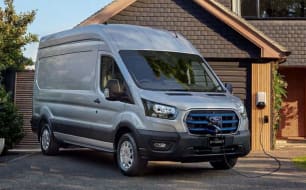It’s easy for drivers of most shapes and sizes to find a comfortable driving position in the spacious cabin, given its height/reach adjustable steering wheel, large left footrest and supportive seating with power-adjustable lumbar support.
Although there’s a huge blind spot over the driver’s left shoulder created by the solid walls of the cargo bay, active driver aids including blind-spot monitoring, rear cross-traffic alert and rear-view camera minimise the potential hazards of changing lanes and reversing out of driveways into busy traffic.
Braking is reassuringly strong and the steering is responsive, with easy manoeuvrability thanks to the conspicuously tight turning circle and lightness of the variable-ratio steering at parking speeds.
The ride quality is reasonably supple when unladen or lightly loaded and, for a van without a bulkhead between the cabin and cargo bay, has comparatively low internal noise levels at speeds up to 80km/h.
The 2.8-litre turbo-diesel, with its sizeable 450Nm of torque, has strong low-rpm response and displays good flexibility in city and suburban driving.
Its performance is optimised by the smooth-shifting six-speed auto, which also delivers fuel-efficient highway travel that requires less than 2000rpm to maintain 110km/h. The sequential manual-shifting function can be handy in certain situations, like carrying/towing heavy loads in hilly terrain.
To test its GVM rating we forklifted 890kg into the cargo bay, which combined with the driver equalled a total payload of 990kg that was only 65kg shy of its 1055kg limit.
The stout rear leaf-springs only compressed about 30mm under this loading, which left more than 60mm of static bump-stop clearance that was more than enough to ensure there was no bottoming-out on our test route.
The turbo-diesel’s ample torque made light work of hauling this payload in city, suburban and highway driving. It was also particularly strong in the hills, where it easily conquered our 13 per cent gradient, 2.0km-long set climb in third gear.
Engine braking on the way down, in a manually selected second gear, wasn’t as strong but far from disgraced given the near one-tonne payload it was trying to restrain. Even so, its four-wheel disc brakes were more than capable of keeping speeds in check.
Our only criticism is the high internal noise levels at highway speeds, when tyre roar through the rear wheel housings can become intolerable over long distances, particularly on coarse bitumen surfaces with an empty cargo bay amplifying the noise.
In our experience, this is a problem shared by all vans at these speeds if they’re not equipped with a sealed cabin bulkhead. So, if your work involves a lot of highway travel, we would recommend fitting one that's available in Toyota’s genuine accessories range. Or buying some earplugs.








.png)


















